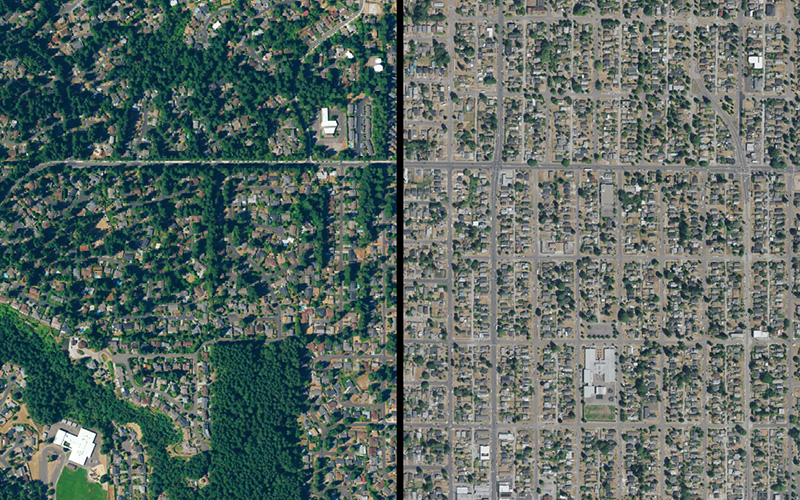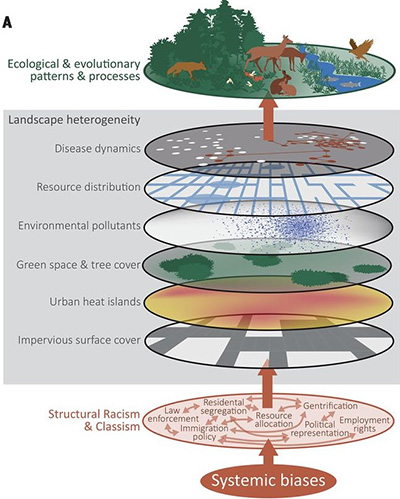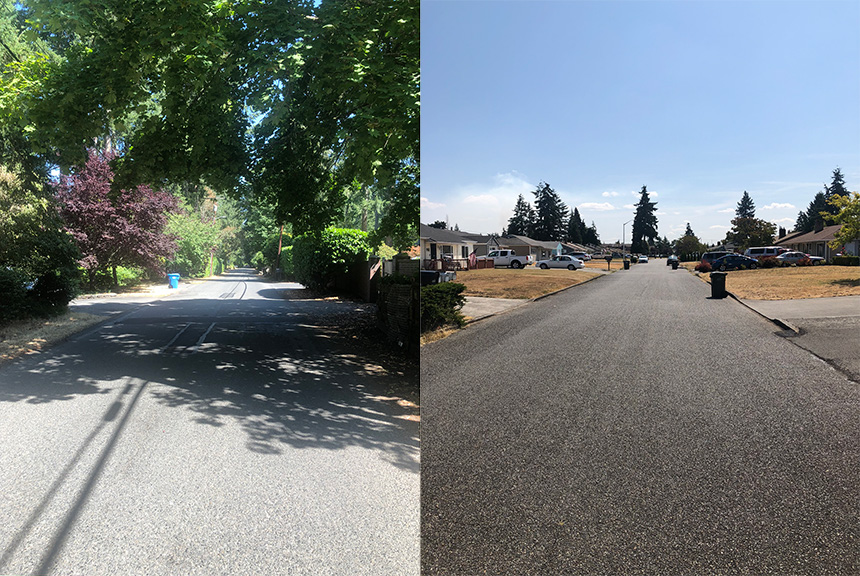
New Science Paper: Racism Affects All Life in Cities
Chris Schell is lead author and Danica Miller is co-author on a review paper in Science that analyzes the influence of systemic inequalities on ecology and evolution.
(Image above: An aerial view showing the differences in tree cover in two neighboring cities. The more affluent city of University Place, Washington (left) has more tree cover, while a neighborhood in the city of Tacoma, Washington (right) has fewer trees. The neighborhoods are about 4.5 miles apart. Photo illustration by Megan Kitagawa/UW Tacoma.)
Social inequalities, specifically racism and classism, are impacting the biodiversity, evolutionary shifts and ecological health of plants and animals in our cities.
That’s the main finding of a review paper led by the University of Washington, with co-authors at the University of California, Berkeley, and University of Michigan, which examined more than 170 published studies and analyzed the influence of systemic inequalities on ecology and evolution. Published Aug. 13 in Science, it calls on the scientific community to focus on environmental justice and anti-racism practices to transform biological research and conservation.
“Racism is destroying our planet, and how we treat each other is essentially structural violence against our natural world,” said lead author Christopher Schell, an assistant professor of urban ecology at the University of Washington Tacoma. “Rather than just changing the conversation about how we treat each other, this paper will hopefully change the conversation about how we treat the natural world.”
The paper cites other studies that have found racism and other inequalities are reducing biodiversity, increasing urban heat island effects and augmenting impacts of climate crises across the United States.
For example, several studies the authors included found fewer trees in low-income and racially minoritized neighborhoods in major cities across the U.S. Less tree cover means hotter temperatures and fewer plant and animal species. Additionally, these areas tend to be closer to industrial waste or dumping sites than wealthier, predominantly white areas — a reality that was put in place intentionally through policies like redlining, the authors explain.

Fewer trees, over decades, has led to pockets of neighborhoods that are hotter, more polluted, and have more disease-carrying pests such as rodents and mosquitoes that can survive in harsh environments. These ecological differences inevitably affect human health and well-being, the authors said.
The main purpose of the paper is to show the scientific community that fundamental practices in science are based on systems that support white supremacy and perpetuate systemic racism, the authors said. They hope their colleagues in science fields will begin to dig into the history of the various laws and practices that built present-day inequalities — such as redlining and Jim Crow laws — and then start to reevaluate how they run their labs and conduct their research.
“I hope this paper will shine the light and create a paradigm shift in science,” Schell said. “That means fundamentally changing how researchers do their science, which questions they ask, and realizing that their usual set of questions might be incomplete.”
For example, Schell said he has seen numerous papers comparing biodiversity in urban and rural areas. However, organisms in cities were often only measured in wealthier areas, negating the possibility for differences among urban neighborhoods of different income levels. That type of science, even if done unknowingly, is negligent, he said.
The authors also hope this paper paves the way for younger scientists entering the field, especially people of color, to have legitimacy in pushing for science that is centered around anti-racism and environmental justice.
“Identity matters, and creating space for researchers who aren’t straight white cis males to pursue questions that arise from their lived experiences can really strengthen science,” said co-author Cleo Woelfle-Erskine, assistant professor and social scientist in the UW School of Marine and Environmental Affairs. “I hope that scientists will read this paper and be inspired to think about representation in our labs and departments, and how that might matter for science going forward.”
Ultimately, the authors said, environmental issues should be recast to encompass societal issues, which departs from what traditional, mostly white environmentalists advocate.

For example, creating affordable housing should be on every environmentalist’s agenda, they explained. More secure housing, with less turnover and fewer vacant lots or construction areas, promotes ecological stability for people, animals and plants. Additionally, more equitable access to parks and greenways within cities also promotes more animal and plant biodiversity. And better public transportation to and from well-paid jobs cuts carbon emissions and reduces animal-vehicle collisions.
Notably, each of these actions benefits humans as well as plants and animals — and all are not included in traditional definitions of environmentalism.
Schell also led a recent paper, in Nature Ecology and Evolution, that lays out tangible actions scientists can take to fight racism and white supremacy. For Schell, this includes paying everyone who works in his lab, making sure people of color are treated equitably, and advocating for women of color to hold leadership positions in professional societies and organizations. He encourages colleagues to do the same.
“I’m hopeful things are going to happen, because I have to be,” he said. “We have the power to be activists in our own ways, in our own sectors, and we have the ability to motivate others to do the same.”
Co-authors are Karen Dyson, Tracy Fuentes and Simone Des Roches of the UW College of Built Environments; Danica Miller of UW Tacoma; Nyeema Harris of the University of Michigan; and Max Lambert of University of California, Berkeley.
This research was funded by the University of Washington, the University of California, Berkeley, the David H. Smith Fellows program and the National Science Foundation.



